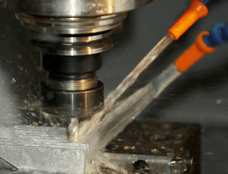At Ardel, we’re always keeping our eyes on new technologies, from force of habit, and to see if they would add any kind of value to the services we provide our customers.
 Lately, there has been a lot of attention and buzz about additive manufacturing, or “3D” printing – we’d like to weigh in on the subject, and also explore other similar technologies from the perspective of a mid-size manufacturer and custom CNC shop.
Lately, there has been a lot of attention and buzz about additive manufacturing, or “3D” printing – we’d like to weigh in on the subject, and also explore other similar technologies from the perspective of a mid-size manufacturer and custom CNC shop.
What many people don’t realize is that “3D printing” (which refers to several processes, the most common of which is called fused deposition modeling) has been around in industry for a while – some of our staff has been aware of and interacting with the technology since ’93! The recent media discovery of the technology has been because its’ affordability has reached the consumer level, and many are realizing and experimenting with the vast capabilities of the technology. Practically for industrial applications however, the only widespread use for additive manufacturing is rapid prototyping. Printing a quick plastic model of a part or product can be valuable, but since the material or alloy capabilities haven’t reached quality specs required for most metal parts (especially in the aerospace and medical industries where we do much of our work), it’s not yet viable as a primary manufacturing technique. One interesting use we’ve seen work to good effect, though, is for workholding on CNC machines – and while this might be used purely for its own sake, the material does function properly, no matter how it was fabricated.
There are a few other fascinating processes we’ve been interested in here at Ardel. One is called stereolithography; like fused deposition modeling, it is another layering process, but uses a laser of ultraviolet light to polymerize, or solidify, one layer of a liquid bath of resin at a time, slowly building the part from the base up. Another is known as selective laser sintering – very similar to stereolithography, but instead of drawing out of a liquid bath, it utilizes intersecting lasers in a vat of powder, and where they intersect, forms layers of globules that build the prototype successively from the bottom up.
There are a host of different manufacturing processes available at this time, and engineers and innovators will only continue to improve and invent new and more precise and useful methods for making things. Our commitment to providing our customers the best machined engineering grade materials possible means that we’re continually on the lookout for new processes and methods of improving our work and our value to our customers – it’s been part of our philosophy since our founding, and we don’t intent to stop anytime soon.

